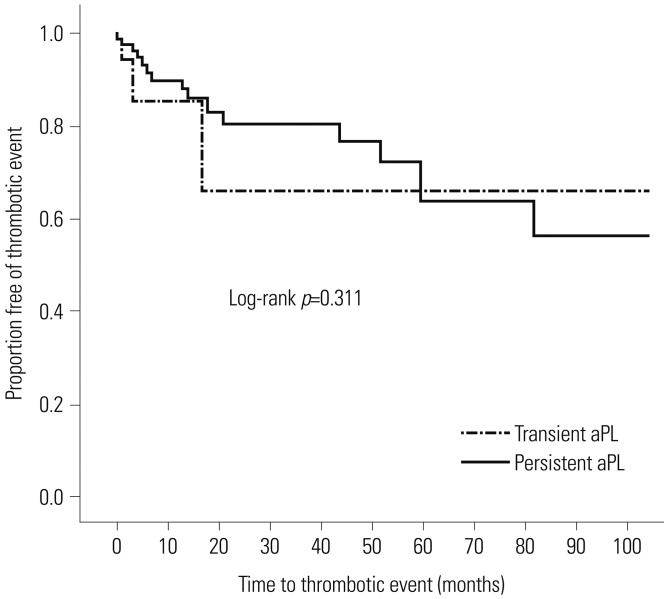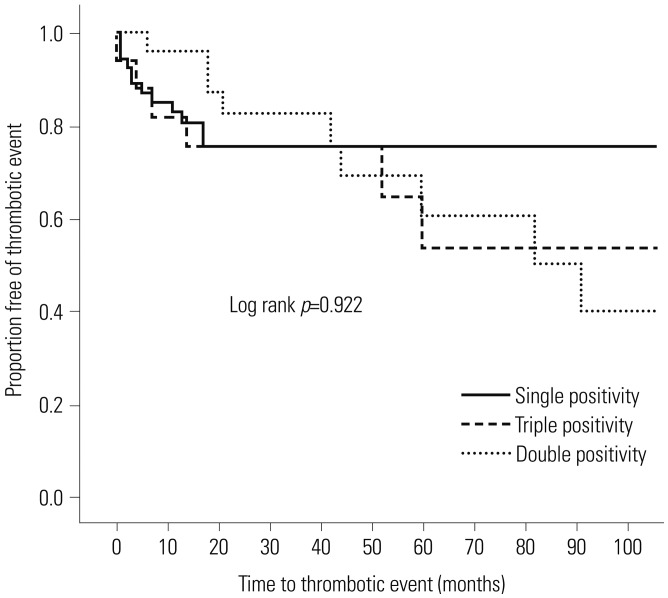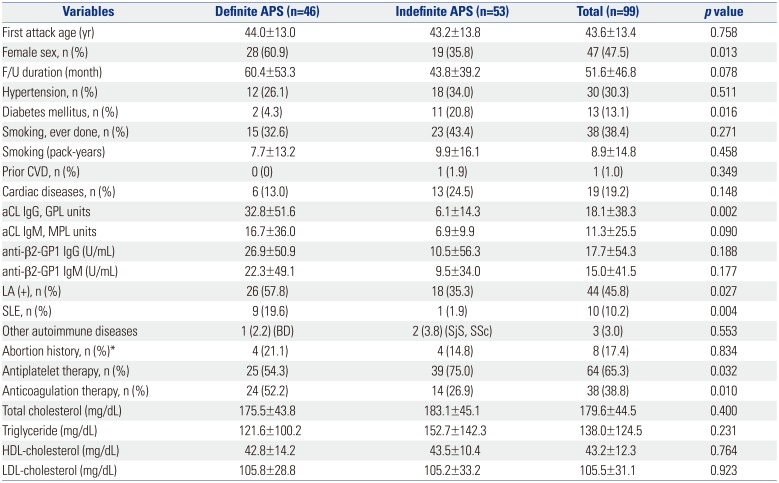1. Krnic-Barrie S, O'Connor CR, Looney SW, Pierangeli SS, Harris EN. A retrospective review of 61 patients with antiphospholipid syndrome. Analysis of factors influencing recurrent thrombosis. Arch Intern Med. 1997; 157:2101–2108. PMID:
9382667.

2. Shah NM, Khamashta MA, Atsumi T, Hughes GR. Outcome of patients with anticardiolipin antibodies: a 10 year follow-up of 52 patients. Lupus. 1998; 7:3–6. PMID:
9493141.

3. Miyakis S, Lockshin MD, Atsumi T, Branch DW, Brey RL, Cervera R, et al. International consensus statement on an update of the classification criteria for definite antiphospholipid syndrome (APS). J Thromb Haemost. 2006; 4:295–306. PMID:
16420554.

4. Shi W, Krilis SA, Chong BH, Gordon S, Chesterman CN. Prevalence of lupus anticoagulant and anticardiolipin antibodies in a healthy population. Aust N Z J Med. 1990; 20:231–236. PMID:
2115326.

5. Vila P, Hernández MC, López-Fernández MF, Batlle J. Prevalence, follow-up and clinical significance of the anticardiolipin antibodies in normal subjects. Thromb Haemost. 1994; 72:209–213. PMID:
7831653.

6. Male C, Foulon D, Hoogendoorn H, Vegh P, Silverman E, David M, et al. Predictive value of persistent versus transient antiphospholipid antibody subtypes for the risk of thrombotic events in pediatric patients with systemic lupus erythematosus. Blood. 2005; 106:4152–4158. PMID:
16144797.

7. Levine SR, Salowich-Palm L, Sawaya KL, Perry M, Spencer HJ, Winkler HJ, et al. IgG anticardiolipin antibody titer > 40 GPL and the risk of subsequent thrombo-occlusive events and death. A prospective cohort study. Stroke. 1997; 28:1660–1665. PMID:
9303006.
8. Ruffatti A, Del Ross T, Ciprian M, Nuzzo M, Rampudda M, Bertero MT, et al. Risk factors for a first thrombotic event in antiphospholipid antibody carriers. A multicentre, retrospective follow-up study. Ann Rheum Dis. 2009; 68:397–399. PMID:
18812393.

9. Erkan D, Barbhaiya M, George D, Sammaritano L, Lockshin M. Moderate versus high-titer persistently anticardiolipin antibody positive patients: are they clinically different and does high-titer anti-β2-glycoprotein-I antibody positivity offer additional predictive information? Lupus. 2010; 19:613–619. PMID:
19934177.

10. Ofer-Shiber S, Molad Y. Frequency of vascular and pregnancy morbidity in patients with low vs. moderate-to-high titers of antiphospholipid antibodies. Blood Coagul Fibrinolysis. 2015; 26:261–266. PMID:
25526601.

11. Stojanovich L, Markovic O, Marisavljevic D, Elezovic I, Ilijevski N, Stanisavljevic N. Influence of antiphospholipid antibody levels and type on thrombotic manifestations: results from the Serbian National Cohort Study. Lupus. 2012; 21:338–345. PMID:
21993381.

12. Espinosa G, Cervera R. Current treatment of antiphospholipid syndrome: lights and shadows. Nat Rev Rheumatol. 2015; 11:586–596. PMID:
26122952.

13. Sciascia S, Sanna G, Khamashta MA, Cuadrado MJ, Erkan D, Andreoli L, et al. The estimated frequency of antiphospholipid antibodies in young adults with cerebrovascular events: a systematic review. Ann Rheum Dis. 2015; 74:2028–2033. PMID:
24942381.

14. Lim W. Antiphospholipid antibody syndrome. Hematology Am Soc Hematol Educ Program. 2009; 233–239. PMID:
20008203.

15. Levine SR, Brey RL, Tilley BC, Thompson JL, Sacco RL, Sciacca RR, et al. Antiphospholipid antibodies and subsequent thrombo-occlusive events in patients with ischemic stroke. JAMA. 2004; 291:576–584. PMID:
14762036.

16. Lim W, Crowther MA, Eikelboom JW. Management of antiphospholipid antibody syndrome: a systematic review. JAMA. 2006; 295:1050–1057. PMID:
16507806.
17. Amory CF, Levine SR, Brey RL, Gebregziabher M, Tuhrim S, Tilley BC, et al. Antiphospholipid antibodies and recurrent thrombotic events: persistence and portfolio. Cerebrovasc Dis. 2015; 40:293–300. PMID:
26513489.

18. Brey RL, Abbott RD, Curb JD, Sharp DS, Ross GW, Stallworth CL, et al. β2-Glycoprotein 1-dependent anticardiolipin antibodies and risk of ischemic stroke and myocardial infarction: the honolulu heart program. Stroke. 2001; 32:1701–1706. PMID:
11486093.
19. Pezzini A, Grassi M, Lodigiani C, Patella R, Gandolfo C, Zini A, et al. Predictors of long-term recurrent vascular events after ischemic stroke at young age: the Italian project on stroke in young adults. Circulation. 2014; 129:1668–1676. PMID:
24508827.
20. Forastiero R, Martinuzzo M, Pombo G, Puente D, Rossi A, Celebrin L, et al. A prospective study of antibodies to β2-glycoprotein I and prothrombin, and risk of thrombosis. J Thromb Haemost. 2005; 3:1231–1238. PMID:
15946213.

21. Lanthier S, Kirkham FJ, Mitchell LG, Laxer RM, Atenafu E, Male C, et al. Increased anticardiolipin antibody IgG titers do not predict recurrent stroke or TIA in children. Neurology. 2004; 62:194–200. PMID:
14745053.

22. Rajamani K, Chaturvedi S, Jin Z, Homma S, Brey RL, Tilley BC, et al. Patent foramen ovale, cardiac valve thickening, and antiphospholipid antibodies as risk factors for subsequent vascular events: the PICSS-APASS study. Stroke. 2009; 40:2337–2342. PMID:
19498198.












 PDF
PDF ePub
ePub Citation
Citation Print
Print



 XML Download
XML Download